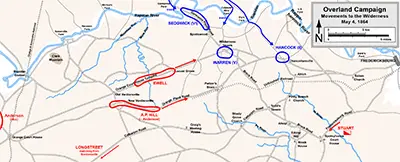Ulysses S. Grant: U.S. President, Civil War Victor
In March 1864, President Abraham Lincoln named Grant general-in-chief of all Union armies. Frustrated by a serious of generals and commanders who preferred caution to aggression, Lincoln had Union troops under Maj. Gen. Winfield Scott Hancock began crossing the Rapidan on May 4 and reached Chancellorsville at midday. At the same time, men under Maj. Gen. John Sedgwick and Maj. Gen. Gouverneur Warren, using pontoon bridges, crossed the river at Germanna Ford. Warren's men were the first to cross and reached Wilderness Tavern, where they stopped. Sedgwick's men populated the road between the tavern and the ford. Grant was waiting for another corps, led by Maj. Gen. Ambrose Burnside, to reinforce from the west. They had not arrived by nightfall on May 4. As dusk fell, the Union troops camped in the Wilderness of Spotsylvania, a large overgrown forest. Such a location would negate the large numbers of men and weapons that the Union could bring to bear should it be attacked. All told, Union troops in the area exceeded 100,000. 
Brambles and branches, roots and stumps stood in the way of both armies as they struggled for purchase in the dense aptly named Wilderness during the two days of combat in the nightmarish area. The smoke from weapons discharges stayed within the umbrella of trees, creating an unnatural fog into which few could see clearly. Friendly fire injuries were rife, as were shots fired at nothing at all. Many soldiers who fell wounded were still on the battlefield that night. A brush fire between the two armies burned many of the wounded. The number of dead swelled. On the morning of May 7, Grant ordered his troops to move out. They had orders to move forward, to the south, not back north or back east or west. Unlike after previous battles, the Army of the Potomac did not retreat; rather, they continued on their march south, to Richmond. Specifically, the order was to capture Spotsylvania Court House, a crossroads that controlled the northern approach to the Confederate capital. |
|
Social Studies for Kids
copyright 2002–2024
David White



 been impressed with Grant's actions in the West. Lincoln and Grant planned a comprehensive set of attacks on the Confederate forces, still with the overall goal of taking Richmond, the capital of
been impressed with Grant's actions in the West. Lincoln and Grant planned a comprehensive set of attacks on the Confederate forces, still with the overall goal of taking Richmond, the capital of 

